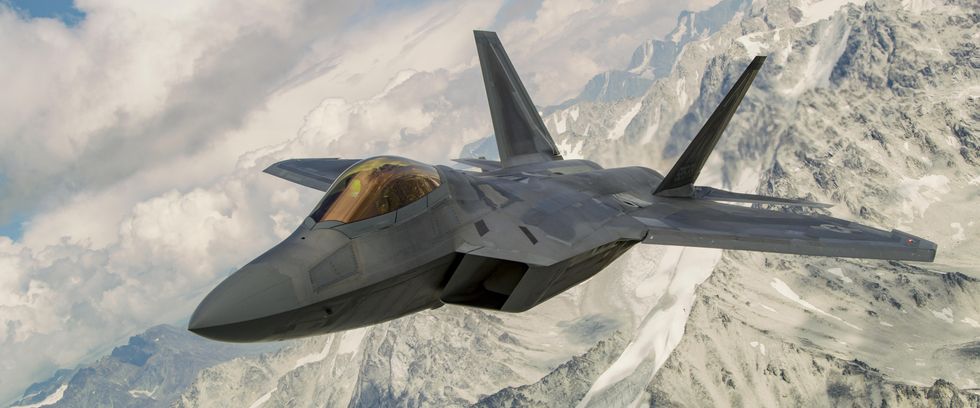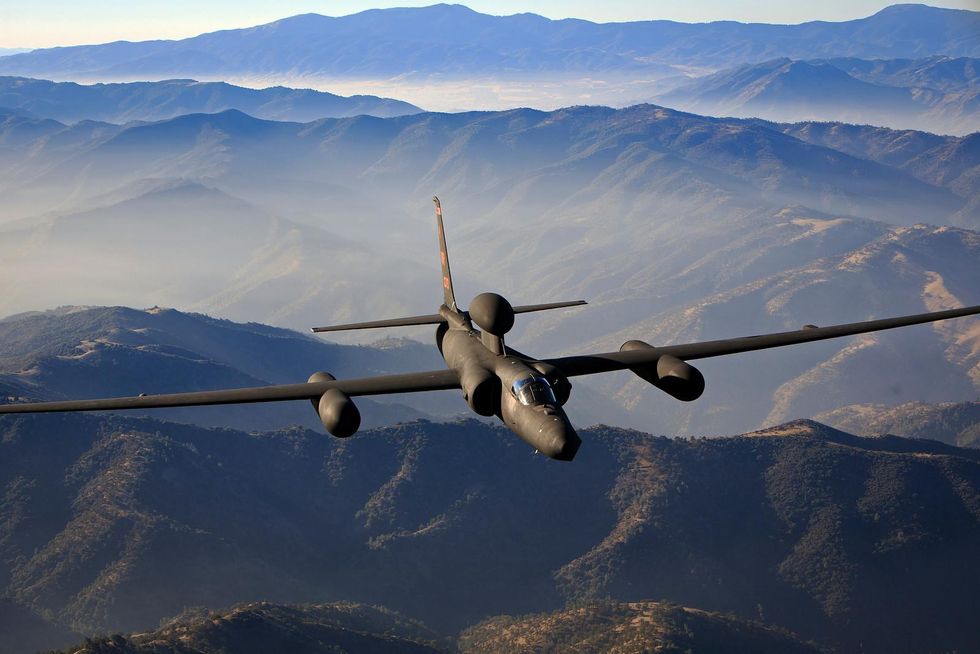Why the World’s Militaries Are Embracing 5G
To fight on tomorrow's more complicated battlefields, militaries must adapt commercial technologies
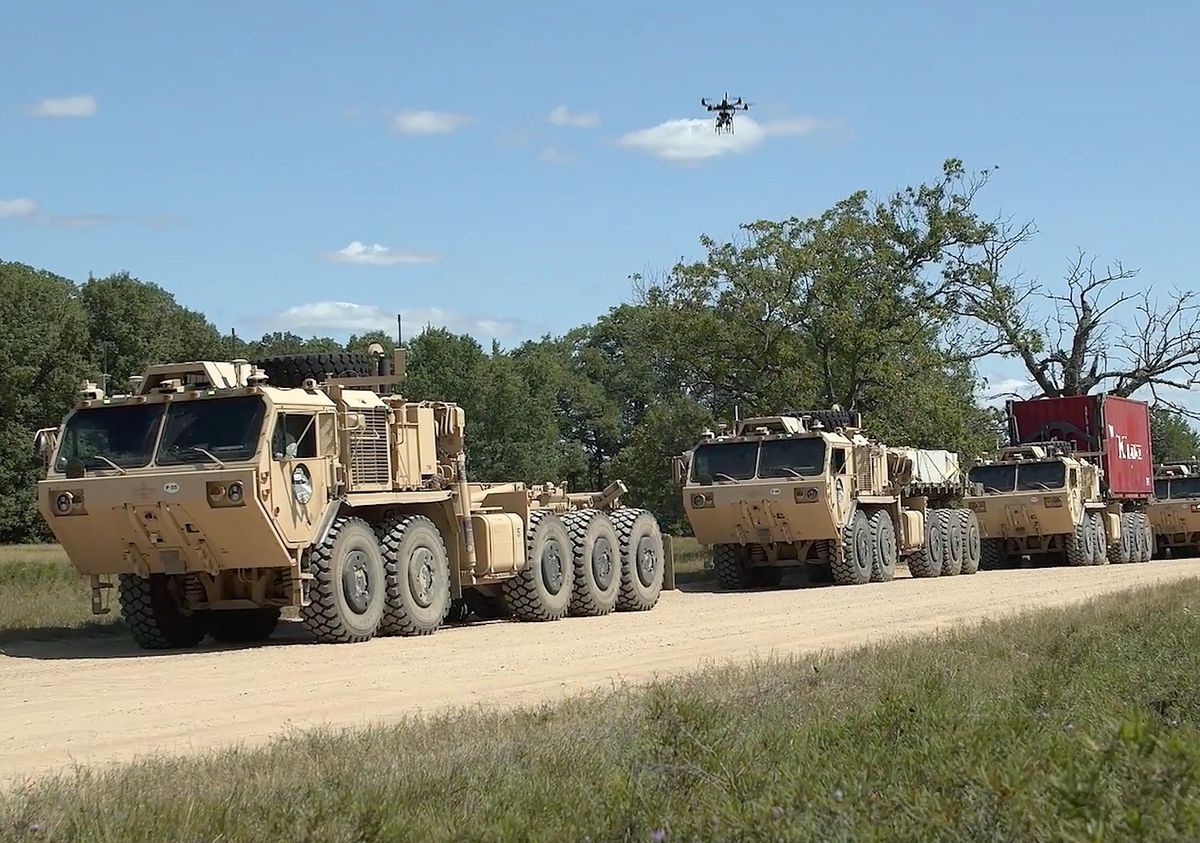
In August 2021, engineers from Lockheed and the U.S. Army demonstrated a flying 5G network, with base stations installed on multicopters, at the U.S. Army's Ground Vehicle Systems Center, in Michigan. Driverless military vehicles followed a human-driven truck at up to 50 kilometers per hour. Powerful processors on the multicopters shared the processing and communications chores needed to keep the vehicles in line.
It's 2035, and the sun beats down on a vast desert coastline. A fighter jet takes off accompanied by four unpiloted aerial vehicles (UAVs) on a mission of reconnaissance and air support. A dozen special forces soldiers have moved into a town in hostile territory, to identify targets for an air strike on a weapons cache. Commanders need live visual evidence to correctly identify the targets for the strike and to minimize damage to surrounding buildings. The problem is that enemy jamming has blacked out the team's typical radio-frequency bands around the cache. Conventional, civilian bands are a no-go because they'd give away the team's position.
As the fighter jet and its automated wingmen cross into hostile territory, they are already sweeping the ground below with radio-frequency, infrared, and optical sensors to identify potential threats. On a helmet-mounted visor display, the pilot views icons on a map showing the movements of antiaircraft batteries and RF jammers, as well as the special forces and the locations of allied and enemy troops.
While all this is going on, the fighter jet's autonomous wingmen establish an ad hoc, high-bandwidth mesh communication network that cuts through the jamming by using unjammed frequencies, aggregating signals across different radio channels, and rapidly switching among different channels. Through a self-organizing network of communication nodes, the piloted fighter in the air connects to the special forces on the ground.
As soon as the network is established, the soldiers begin transmitting real-time video of artillery rockets being transported into buildings. The fighter jet acts as a base station, connecting the flying mesh network of the UAVs with a network of military and commercial satellites accessible to commanders all over the world. Processors distributed among the piloted and unpiloted aircraft churn through the data, and artificial-intelligence (AI) algorithms locate the targets and identify the weapons in the live video feed being viewed by the commanders.
Suddenly, the pilot sees a dot flashing on the far horizon through his helmet-mounted display. Instantly, two of the four teammates divert toward the location indicated by the flash. The helmet lights up a flight path toward the spot, and the pilot receives new orders scrolling across the display:
New Priority: SEARCH AND RESCUE
Downed Pilot, 121 miles NNW
Execute Reconnaissance and Grid Search, Provide Air Cover
The two UAVs that have flown ahead start coordinating to identify the location of hostile forces in the vicinity of the downed aircraft. A Navy rescue helicopter and medical support vessel are alreadyen route. Meanwhile, with the fighter jet speeding away on a new mission, the two other UAVs supporting the special forces squad shift their network configuration to directly link to the satellite networks now serving the base-station role formerly played by the fighter jet. The live video feed goes on uninterrupted. The reconfigurations happen swiftly and without human intervention.
Warfare has always been carried out at the boundary between chaos and order. Strategists have long tried to suppress the chaos and impose order by means of intelligence, communication, and command and control. The most powerful weapon is useless without knowing where to aim it. The most carefully constructed plan leads nowhere if it is based on bad intelligence. And the best intelligence is worthless if it arrives too late. No wonder that over the past two centuries, as technologies such as photography, electronic communications, and computing became available, they were quickly absorbed into military operations and often enhanced by targeted defense R&D.
The next key enabler is fifth-generation ( 5G) wireless communications. The United States, Europe, China, and Russia are now integrating 5G technologies into their military networks. These are sizable and complicated projects, and several different strategies are already becoming apparent.
At Lockheed Martin, we're enhancing standard 5G technologies to connect the many platforms and networks that are fielded by the various branches of the armed services. We call this our 5G.MIL initiative. Earlier this year, in two projects, called Hydra and HiveStar, we demonstrated the feasibility of key aspects of this initiative. Hydra yielded encouraging results on the interoperability challenge, and HiveStar showed that it was possible to quickly construct, in an area with no existing infrastructure, a highly mobile and yet capable 5G network, as would be required on a battlefield.
The new work takes an unusual approach. It is a collaboration with commercial industry in which technology is transferred from the civilian to the military sector, not the other way around. Radar, rocketry, and nuclear energy got their starts in military labs, and it took years, even generations, for these technologies to trickle into consumer products. But today, for fundamental technologies such as computing and communications, the sheer scale of private-sector development is increasingly beyond the resources of even the largest national defense agencies. To deploy networks that are sufficiently fast, adaptive, agile, and interoperable, warfighters now have little alternative but to exploit commercial developments.
No wonder, then, that the U.S. Department of Defense, through an initiative called 5G to NextG, and various complementary investments from individual armed services, has committed upwards of US $2 billion to advance commercial 5G research and to perform tests and experiments to adapt the results for military purposes.
To understand the significance of such a shift, consider how the United States got to this juncture. In 18th-century conflicts, such as the Revolutionary War, the only battlefield sensors were human eyes and ears. Long-distance communication could take days and could be interrupted if the messengers it relied on were captured or killed. Tactical battlefield decisions were signaled by flags or runners to commence maneuvers or attacks.
By World War II, combatants had radar, aircraft, and radios to sense enemy planes and bombers up to 80 miles ahead. They could communicate from hundreds of miles away and prepare air defenses and direct fighter-interceptor squadrons within minutes. Photoreconnaissance could supply invaluable intelligence—but in hours or days, not seconds.
Today, the field of battle is intensively monitored. There are countless sensors on land, sea, air, space, and even in cyberspace. Jet fighters, such as the F-35, can act as information-processing hubs in the sky to fuse all that data into a single integrated picture of the battlefield, then share that picture with war fighters and decision makers, who can thus execute command and control in near real time.
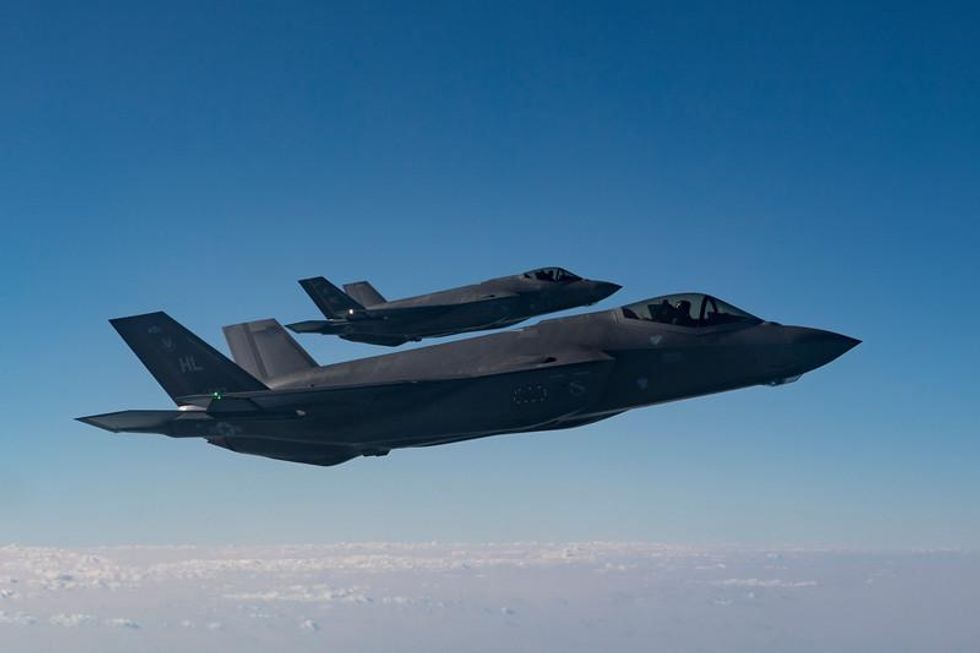
At least, that's the goal. The reality often falls short. The networks that knit together all these sensors are a patchwork. Some of them run over civilian commercial infrastructure and others are military, and among the military ones, different requirements among the different branches and other factors have contributed to an assortment of high-performance but largely incompatible communication protocols. Messages may not propagate across these networks quickly or at all.
Here's why that's a problem. Say that an F-35 detects an incoming ballistic missile. The aircraft can track the missile in real time. But today it may not be able to convey that tracking data all the way to antimissile batteries in time for them to shoot down the projectile. That's the kind of capability the 5G.MIL initiative is aiming for.
There are broader goals, too, because future battlefields will up the ante on complexity. Besides weapons, platforms, and gear, individual people will be outfitted with network-connected sensors monitoring their location, exposures to biochemical or radioactive hazards, and physical condition. To connect all these elements will require global mesh networks of thousands of nodes, including satellites in space. The networks will have to accommodate hypersonic systems moving faster than five times the speed of sound, while also being capable of controlling or launching cyberattacks, electronic warfare and countermeasures, and directed-energy weapons.
Such technologies will fundamentally change the character and speed of war and will require an omnipresent communications backbone to manage capabilities across the entire battlefield. The sheer range of coordinated activities, the volume of assets, the complexity of their interactions, and their worldwide distribution would quickly overwhelm the computing and network capabilities we have today. The time from observation to decision to action will be measured in milliseconds: When a maneuvering hypersonic platform moves more than 3.5 kilometers per second, knowing its location even a second ago may be of little use for a system designed to track it.
Our 5G.MIL vision has two complementary elements. One is exemplified by the opening scenario of this article: the quick, ad hoc establishment of secure, local networks based on 5G technology. The goal here is to let forces take sensor data from any platform in the theater and make it accessible to any shooter, no matter how the platform and the shooter each connect to the network.
Lockheed Martin
Aircraft, ships, satellites, tanks, or even individual soldiers could connect their sensors to the secure 5G network via specially modified 5G base stations. Like commercial 5G base stations, these hybrid base stations could handle commercial 5G and 4G LTE cellular traffic. They could also share data via military tactical links and communications systems. In either case, these battlefield connections would take the form of secure mesh networks. In this type of network, nodes have intelligence that enables them to connect to one another directly to self-organize and self-configure into a network, and then jointly manage the flow of data.
Inside the hybrid base station would be a series of systems called tactical gateways, which enable the base station to work with different military communication protocols. Such gateways already exist: They consist of hardware and software based on military-prescribed open-architecture standards that enable a platform, such as a fighter jet made by one contractor, to communicate with, say, a missile battery made by another supplier.
The second element of the 5G.MIL vision involves connecting these local mesh networks to the global Internet. Such a connection between a local network and the wider Internet is known as a backhaul. In our case, the connection might be on the ground or in space, between civilian and military satellites. The resulting globe-spanning backhaul networks, composed of civilian infrastructure, military assets, or a mixture of both, would in effect create a software-defined virtual global defense network.
The software-defined aspect is important because it would allow the networks to be reconfigured—automatically—on the fly. That's a huge challenge right now, but it's critical because it would provide the flexibility needed to deal with the exigencies of war. At one moment, you might need an enormous video bandwidth in a certain area; in the next, you might need to convey a huge amount of targeting data. Alternatively, different streams of data might need different levels of encryption. Automatically reconfigurable software-defined networks would make all of this possible.
The military advantage would be that software running on the network could use data sourced from anywhere in the world to pinpoint location, identify friends or foes, and to target hostile forces. Any authorized user in the field with a smartphone could see on a Web browser, with data from this network, the entire battlefield, no matter where it was on the planet.
We partnered recently with the U.S. Armed Services to demonstrate key aspects of this 5G.MIL vision. In March 2021, Lockheed Martin's Project Hydra demonstrated bidirectional communication between the Lockheed F-22 and F-35 stealth fighters and a Lockheed U-2 reconnaissance plane in flight, and then down to ground artillery systems.
This latest experiment, part of a series that began in 2013, is an example of connecting systems with communications protocols that are unique to their mission requirements. All three planes are made by Lockheed Martin, but their different chronologies and battlefield roles resulted in different custom communications links that aren't readily compatible. Project Hydra enabled the platforms to communicate directly via an open-system gateway that translates data between native communications links and other weapons systems.
Emerging technologies will fundamentally change the character and speed of war and will require an omnipresent communications backbone to manage capabilities across the entire battlefield.
It was a promising outcome, but reconnaissance and fighter aircraft represent only a tiny fraction of the nodes in a future battle space. Lockheed Martin has continued to build off Project Hydra, introducing additional platforms in the network architecture. Extending the distributed-gateway approach to all platforms can make the resulting network resilient to the loss of individual nodes by ensuring that critical data gets through without having to spend money to replace existing platform radios with a new, common radio.
Another series of projects with a software platform called HiveStar showed that a fully functional 5G network could be assembled using base stations about the size of a cereal box. What's more, those base stations could be installed on modestly sized multicopters and flown around a theater of operations—this network was literally "on the fly."
The HiveStar team carried out a series of trials this year culminating in a joint demonstration with the U.S. Army's Ground Vehicle Systems Center. The objective was to support a real-world Army need: using autonomous vehicles to deliver supplies in war zones.
The team started simply, setting up a 5G base station and establishing a connection to a smartphone. The base-station hardware, a gNodeB in industry parlance, was an OctNode2, from Octasic in Montreal. The base station weighs about 800 grams and measures about 24 × 15 × 5 centimeters.
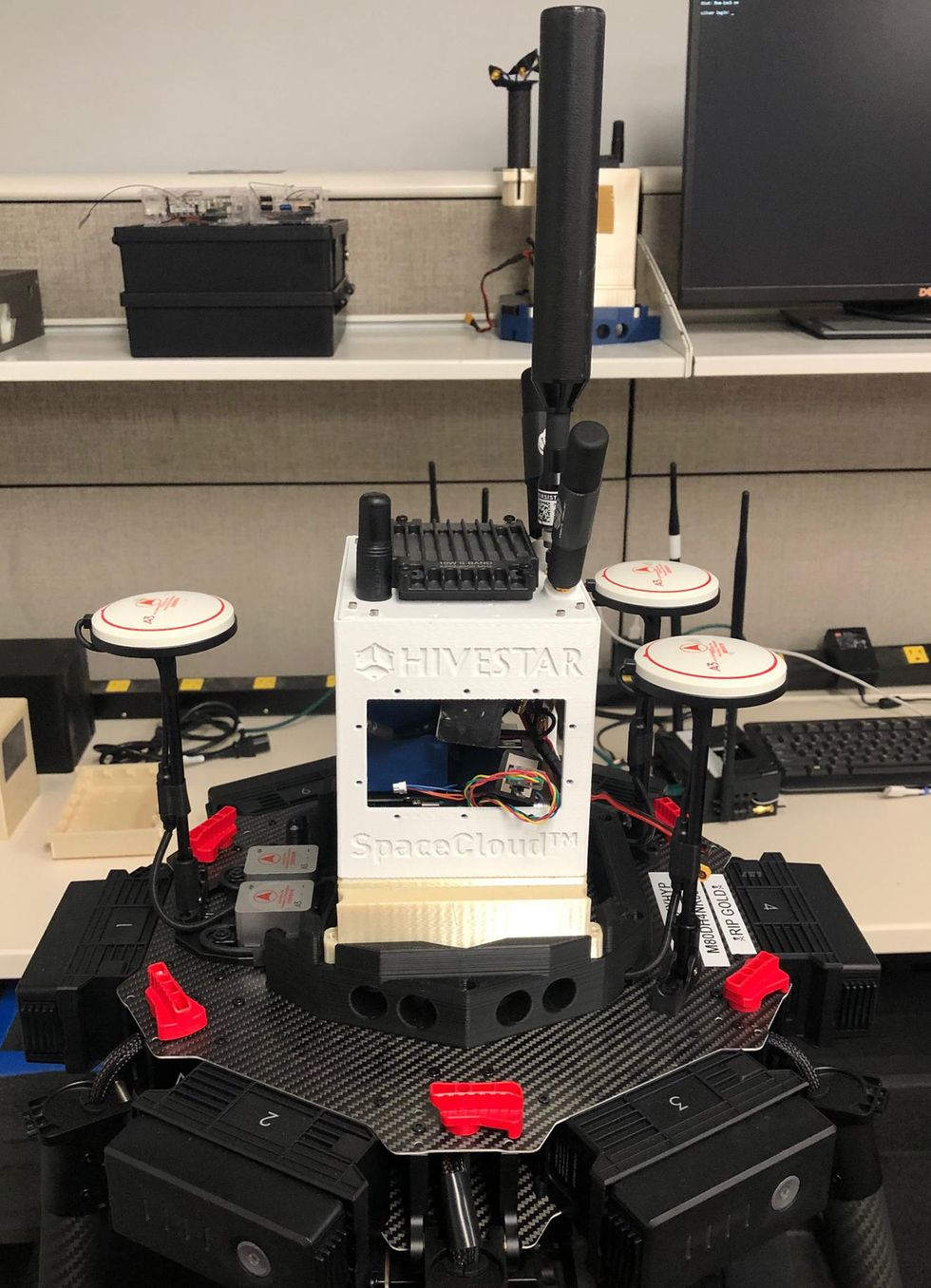
The team then tested the compact system in an area without existing infrastructure, as might very well be true of a war zone or disaster area. The team mounted the gNodeB and a tactical radio operating in the S band on a DJI Matrice 600 Pro hexacopter and flew the package over a test range at Lockheed Martin's Waterton, Colo., facility. The system passed the test: It established 5G connectivity between this roving cell tower in the sky with a tablet on the ground.
Next, the team set about wirelessly connecting a group of base stations together into a flying, roving heterogeneous 5G military network that could perform useful missions. For this they relied on Lockheed-Martin developed software called HiveStar, which manages network coverage and distributes tasks among network nodes—in this case, the multicopters cooperating to find and photograph the target. This management is dynamic: if one node is lost to interference or damage, the remaining nodes adjust to cover the loss.
For the team's first trial, they chose a pretty standard military chore: locate and photograph a target using multiple sensor systems, a function called tip and cue. In a war zone such a mission might be carried out by a relatively large UAV outfitted with serious processing power. Here the team used the gNodeB and S-band radio setup as before, but with a slight difference. All 5G networks need a software suite called 5G core services, which is responsible for such basic functions as authenticating a user and managing the handoffs from tower to tower. In this trial, those core functions were running on a standard Dell PowerEdge R630 1U rack-mounted server on the ground. So the network consisted of the gNodeB on the lead copter, which communicated with the ground using 5G and depended on the core services on the ground computers.
The lead copter communicated using S-band radio links, with several camera copters and one search copter with a software-defined radio programmed to detect an RF pulse in the target frequency. The team worked with the HiveStar software, which managed the network's communications and computing, via the 5G tablet. All that was needed was a target for the copters to search for. So the team outfitted a remotely controlled toy jeep, about 1 meter long, with a software-defined radio emitter as a surrogate target.
The team initiated the tip-and-cue mission by entering commands on the 5G tablet. The lead copter acted as a router to the rest of the heterogeneous 5G and S-band network. Messages initiating the mission were then distributed to the other cooperating copters via the S-band radio connection. Once these camera platforms received the messages, their onboard HiveStar mission software cooperated to autonomously distribute tasks among the team to execute search maneuvers. The multicopters lifted off in search of the target RF emitter.
Once the detecting copter located the target jeep's radio signal, the camera copters quickly sped to the area and captured images of the jeep. Then, via the 5G gNodeB, they sent these images, along with precise latitude and longitude information, to the tablet. Mission accomplished.
Next the team thought of ways to fly the entire 5G system, freeing it from any dependence on specific locations on the ground. To do this, they had to put the 5G core services on the lead copter, the one outfitted with the gNodeB. Working with a partner company, they loaded the core services software onto a single board computer, an Nvidia Jetson Xavier NX, along with the gNodeB. For the lead copter, which would carry this gear, they chose a robust, industrial-grade quadcopter, the Freefly Alta X. They equipped it with the Nvidia board, antennas, filters, and the S-band radios.
Lockheed Martin
At the Army's behest, the team came up with a plan to use the flying network to demonstrate leader-follower autonomous-vehicle mobility. It's a convoy: A human drives a lead vehicle, and up to eight autonomous vehicles follow behind, using routing information transmitted to them from the lead vehicle. Just as in the tip-and-cue demonstration, the team established a heterogeneous 5G and S-band network with the upgraded 5G payload and a series of supporting copters that formed a connected S-band mesh network. This mesh connected the convoy to a second, identical convoy several kilometers away, which was also served by a copter-based 5G and S-band base station.
After the commander initiated the mission, the Freefly Alta X flew itself above the lead vehicle at a height of about 100 meters and connected to it via the 5G link. The HiveStar mission-controller software directed the supporting multicopters to launch, form, and maintain the mesh network. The vehicle convoy started its circuit around a test range about 10 km in circumference. During this time, the copter connected via 5G to the lead convoy vehicle would relay position and other telemetric information to the other vehicles in the convoy, while following overhead as the convoy traveled at around 50 km per hour. Data from the lead vehicle was shared by this relay to following vehicles as well as the second convoy via the distributed multicopter-based S-band mesh network.
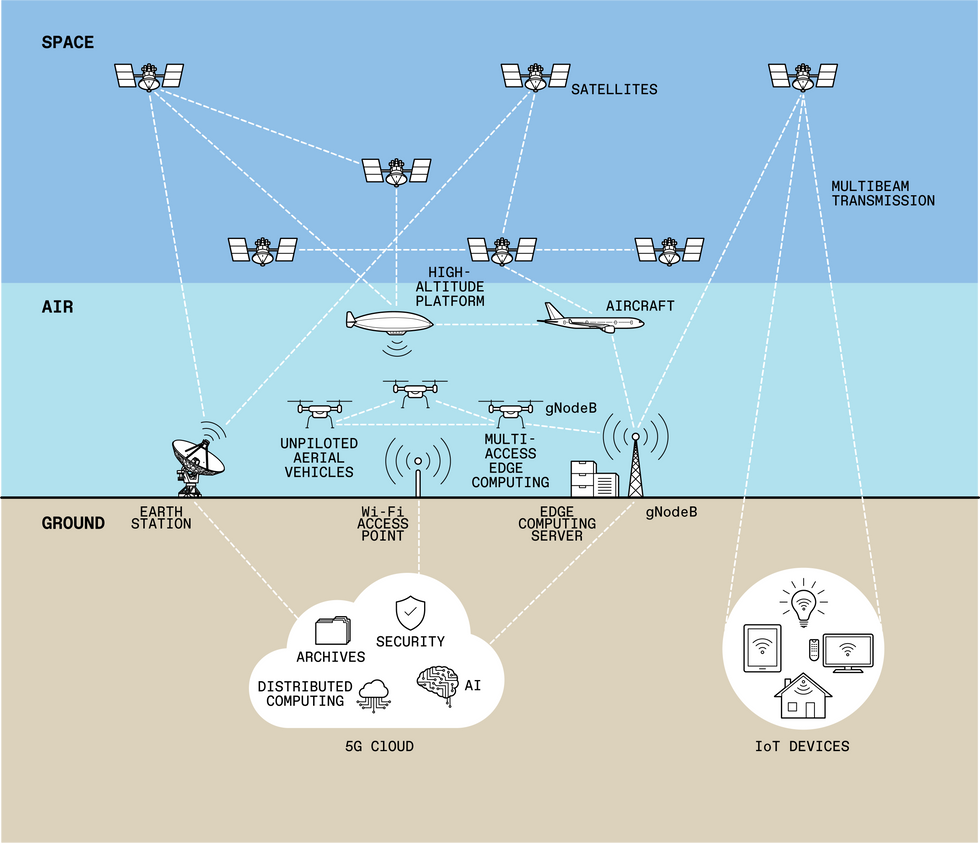
The team also challenged the system by simulating the loss of one of the data links (either 5G or S-band) due to jamming or malfunction. If a 5G link was severed, the system immediately switched to the S band, and vice versa, to maintain connectivity. Such a capability would be important in a war zone, where jamming is a constant threat.
Though encouraging, the Hydra and HiveStar trials were but first steps, and many high hurdles will have to be cleared before the scenario that opens this article can become reality. Chief among these is expanding the coverage and range of the 5G-enabled networks to continental or intercontinental range, increasing their security, and managing their myriad connections. We are looking to the commercial sector to bring big ideas to these challenges.
Satellite constellations, for instance, can provide a degree of global coverage, along with cloud-computing services via the internet and the opportunity for mesh networking and distributed computing. And though today's 5G standards do not include space-based 5G access, the Release 17 standards coming in 2022 from the 3rd Generation Partnership Project consortium will natively support nonterrestrial networking capabilities for the 5G ecosystem. So we're working with our commercial partners to integrate their 3GPP-compliant capabilities to enable direct-to-device 5G connectivity from space. In the meantime, we're using the HiveStar/multicopter platform as a surrogate to test and demonstrate our space-based 5G concepts.
Security will entail many challenges. Cyberattackers can be counted on to attempt to exploit any vulnerabilities in the software-defined networking and network-virtualization capabilities of the 5G architecture. The huge number of vendors and their suppliers will make it hard to perform due diligence on all of them. And yet we must protect against such attacks in a way that works with any vendor's products rather than rely, as in the past, on a limited pool of preapproved solutions with proprietary (and incompatible) security modifications.
The advent of ultrafast 5G technology is an inflection point in military technology.
Another interesting little challenge is presented by the 5G waveform itself. It's made to be easily discovered to establish the strongest connection. But that won't work in military operations where lives depend on stealth. Modifications to the standard 5G waveform, and how it's processed within the gNodeB, can achieve transmission that's hard for adversaries to pick up.
Perhaps the greatest challenge, though, is how to orchestrate a global network built on mixed commercial and military infrastructure. To succeed here will require collaboration with commercial mobile-network operators to develop better ways to authenticate user connections, control network capacity, and share RF spectrum. For software applications to make use of 5G's low latency, we'll also have to find new, innovative ways of managing distributed cloud-computing resources.
It's not a leap to see the advent of ultrafast 5G technology as an inflection point in military technology. As artificial intelligence, unpiloted systems, directed-energy weapons, and other technologies become cheaper and more widely available, threats will proliferate in both number and diversity. Communications and command and control will only become more important relative to more traditional factors such as the physical capabilities of platforms and kinetic weapons. This sentiment was highlighted in the summary of the 2018 U.S. National Defense Strategy, the strategic guidance document issued every four years by the U.S. DOD: "Success no longer goes to the country that develops a new technology first, but rather to the one that better integrates it and adapts its way of fighting."
Here, it is worth noting that Chinese companies are among the most active in developing 5G and emerging 6G technologies. Chinese firms, notably Huawei and ZTE Corp., have more than 30 percent of the worldwide market for 5G technology, similar to the combined market shares of Ericsson and Nokia. Chinese market share could very well increase: According to the Council on Foreign Relations, the Chinese government backs companies that build 5G infrastructures in countries China invests in as part of its Belt and Road Initiative. Meanwhile, in Europe, NATO unveiled its first 5G military test site in Latvia in 2020. Norway, notably, is exploring dedicating software-defined networks in commercial 5G infrastructure to support military missions.
Perhaps this convergence of commercial and defense-sector development around 5G, 6G, and future communications technologies will lead to powerful and unexpected commercial applications. The defense sector gave the world the Internet. The world now gives militaries 5G communications and beyond. Let's find out what the defense sector can give back.
Authors' note: 5G.MIL, HiveStar, and Lockheed Martin are all trademarks of the Lockheed Martin Corporation. The authors wish to acknowledge the help of Brandon Martin in the writing of this article.
